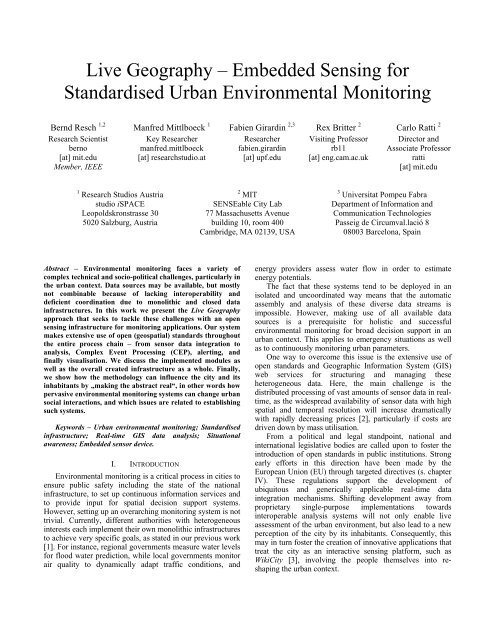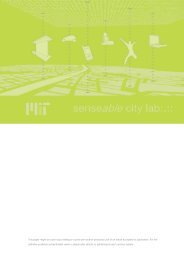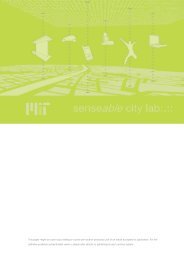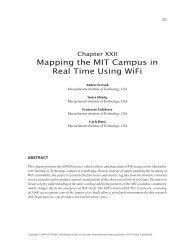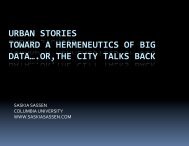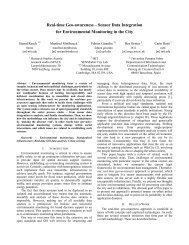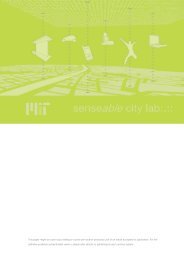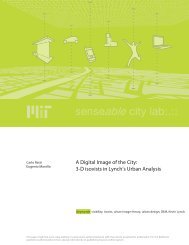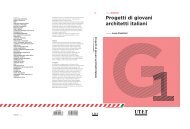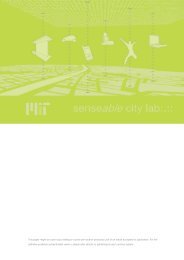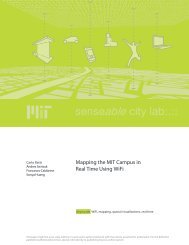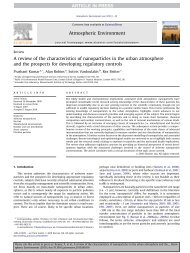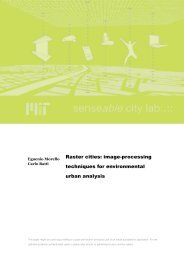Live Geography – <strong>Embedded</strong> <strong>Sensing</strong> <strong>for</strong><strong>Standardised</strong> <strong>Urban</strong> <strong>Environmental</strong> <strong>Monitoring</strong>Bernd Resch 1,2Research Scientistberno[at] mit.eduMember, IEEEManfred Mittlboeck 1Key Researchermanfred.mittlboeck[at] researchstudio.atFabien Girardin 2,3Researcherfabien.girardin[at] upf.eduRex Britter 2Visiting Professorrb11[at] eng.cam.ac.ukCarlo Ratti 2Director andAssociate Professorratti[at] mit.edu1 Research Studios Austriastudio iSPACELeopoldskronstrasse 305020 Salzburg, Austria2 MITSENSEable City Lab77 Massachusetts Avenuebuilding 10, room 400Cambridge, MA 02139, USA3 Universitat Pompeu FabraDepartment of In<strong>for</strong>mation andCommunication TechnologiesPasseig de Circumval.lació 808003 Barcelona, SpainAbstract – <strong>Environmental</strong> monitoring faces a variety ofcomplex technical and socio-political challenges, particularly inthe urban context. Data sources may be available, but mostlynot combinable because of lacking interoperability anddeficient coordination due to monolithic and closed datainfrastructures. In this work we present the Live Geographyapproach that seeks to tackle these challenges with an opensensing infrastructure <strong>for</strong> monitoring applications. Our systemmakes extensive use of open (geospatial) standards throughoutthe entire process chain – from sensor data integration toanalysis, Complex Event Processing (CEP), alerting, andfinally visualisation. We discuss the implemented modules aswell as the overall created infrastructure as a whole. Finally,we show how the methodology can influence the city and itsinhabitants by „making the abstract real“, in other words howpervasive environmental monitoring systems can change urbansocial interactions, and which issues are related to establishingsuch systems.Keywords – <strong>Urban</strong> environmental monitoring; <strong>Standardised</strong>infrastructure; Real-time GIS data analysis; Situationalawareness; <strong>Embedded</strong> sensor device.I. INTRODUCTION<strong>Environmental</strong> monitoring is a critical process in cities toensure public safety including the state of the nationalinfrastructure, to set up continuous in<strong>for</strong>mation services andto provide input <strong>for</strong> spatial decision support systems.However, setting up an overarching monitoring system is nottrivial. Currently, different authorities with heterogeneousinterests each implement their own monolithic infrastructuresto achieve very specific goals, as stated in our previous work[1]. For instance, regional governments measure water levels<strong>for</strong> flood water prediction, while local governments monitorair quality to dynamically adapt traffic conditions, andenergy providers assess water flow in order to estimateenergy potentials.The fact that these systems tend to be deployed in anisolated and uncoordinated way means that the automaticassembly and analysis of these diverse data streams isimpossible. However, making use of all available datasources is a prerequisite <strong>for</strong> holistic and successfulenvironmental monitoring <strong>for</strong> broad decision support in anurban context. This applies to emergency situations as wellas to continuously monitoring urban parameters.One way to overcome this issue is the extensive use ofopen standards and Geographic In<strong>for</strong>mation System (GIS)web services <strong>for</strong> structuring and managing theseheterogeneous data. Here, the main challenge is thedistributed processing of vast amounts of sensor data in realtime,as the widespread availability of sensor data with highspatial and temporal resolution will increase dramaticallywith rapidly decreasing prices [2], particularly if costs aredriven down by mass utilisation.From a political and legal standpoint, national andinternational legislative bodies are called upon to foster theintroduction of open standards in public institutions. Strongearly ef<strong>for</strong>ts in this direction have been made by theEuropean Union (EU) through targeted directives (s. chapterIV). These regulations support the development ofubiquitous and generically applicable real-time dataintegration mechanisms. Shifting development away fromproprietary single-purpose implementations towardsinteroperable analysis systems will not only enable liveassessment of the urban environment, but also lead to a newperception of the city by its inhabitants. Consequently, thismay in turn foster the creation of innovative applications thattreat the city as an interactive sensing plat<strong>for</strong>m, such asWikiCity [3], involving the people themselves into reshapingthe urban context.
This paper begins with a review of related work inseveral research areas. Then, challenges of environmentalmonitoring with particular respect to the urban context areelucidated, be<strong>for</strong>e we summarise the current legalframeworks <strong>for</strong> environmental data management. Thereafter,our Live Geography approach is presented, which aims tointegrate live sensor measurements with archived datasources on the server side in a highly flexible andinteroperable infrastructure. Finally, we present our thoughtson how environmental sensing and Geographic In<strong>for</strong>mation(GI) processing can affect the city and its inhabitants. Theultimate goal of this paper is to present our approach’spotential impact on urban policy and decision-making, and topoint out its portability to other application domains.II. RELATED WORKThe Live Geography approach is manifold in terms ofboth concepts and employed technologies. As such, there areseveral research initiatives that <strong>for</strong>m part of the overallmethodology. These are described below.The first domain is sensor network development <strong>for</strong>environmental monitoring. The Oklahoma City Micronet[4] is a network of 40 automated environmental monitoringstations across the Oklahoma City metropolitan area. Thenetwork consists of 4 Oklahoma Mesonet stations and 36sites mounted on traffic signals. At each traffic signal site,atmospheric conditions are measured and transmitted everyminute to a central facility. The Oklahoma ClimatologicalSurvey receives the observations, verifies the quality of thedata and provides the data to Oklahoma City Micronetpartners and customers. One major shortcoming of thesystem is that it is a much specialised implementation notusing open standards or aiming at portability. The sameapplies to CORIE [5], which is a pilot environmentalobservation and <strong>for</strong>ecasting system (EOFS) <strong>for</strong> the ColumbiaRiver. It integrates a real-time sensor network, a datamanagement system and advanced numerical models.Secondly, there are a number of approaches toleveraging sensor in<strong>for</strong>mation in GIS applications. [6]presents the SenseWeb project, which aims to establish aWikipedia-like sensor plat<strong>for</strong>m. The project seeks to allowusers to include their own sensors in the system and thusleverage the „community effect“, building a dense networkof sensors by aggregating existing and newly deployedsensors within the SenseWeb application. Although theauthors discuss data trans<strong>for</strong>mation issues, data fusion, andsimple GIS analysis, the system architecture is not based onopen (geospatial) standards, only standard web services. Theweb portal implementation, called SensorMap, uses theSensor Description Markup Language (SDML), anapplication-specific dialect of the Open GeospatialConsortium (OGC) SensorML standard.In [7], the author presents a sensing infrastructure thatattempts to combine sensor systems and GIS-basedvisualisation technologies. The sensing devices, whichmeasure rock temperature at ten minute intervals, focuses onoptimising resource usage, including data aggregation,power consumption, and communication within the sensornetwork. In its current implementation, the infrastructuredoes not account <strong>for</strong> geospatial standards in sensorobservations. The visualisation component uses a number ofopen standards (OGC Web Map Service [WMS], WebFeature Service [WFS]) and open-source services (UMNMap Server, Mapbender).Another sensing infrastructure is described in [8]. TheCitySense project uses an urban sensor network to measureenvironmental parameters and is thus the data source <strong>for</strong>further data analysis. The project focuses on the developmentof a city-wide sensing system using an optimised networkinfrastructure. An important parallel with the work presentedin this paper is that CitySense also considers therequirements of sensor network setup in an urbanenvironment.A GIS mashup <strong>for</strong> environmental data visualisation ispresented in the nowCOAST application [9]. Data fromseveral public providers are integrated in a web-basedgraphical user interface. nowCOAST visualises several typesof raw environmental parameters and also offers a 24-hoursea surface temperature interpolation plot.The most striking shortcoming of the approachesdescribed above and other related ef<strong>for</strong>ts is that their systemarchitectures are at best partly based on open (geospatial)standards.The third related research area is real-time dataintegration <strong>for</strong> GIS analysis systems. Most currentapproaches use web services based on the classicrequest/response model. Although partly using open GISstandards, they are often unsuitable <strong>for</strong> the real-timeintegration of large volumes of data. [10] establishes a realtimespatial data infrastructure (SDI), which per<strong>for</strong>ms severalapplication-specific steps (coordinate trans<strong>for</strong>mation, spatialdata generalisation, query processing or map rendering andadaptation), but accounts neither <strong>for</strong> event-based pushmechanisms nor <strong>for</strong> the integration of sensor data.Other approaches <strong>for</strong> real-time data integration rely onthe costly step of creating a temporal database. Oracle’ssystem, presented in [11], is essentially a middlewarebetween (web) services and a continuously updated databaselayer. Like Sybase’s method [12], the Oracle approachdetects database events in order to trigger analytical actionsaccordingly. In [13], a more dynamic method of dataintegration and fusion is presented using on-the-fly objectmatching and metadata repositories to create a flexible dataintegration environment.The fourth comprised research field is the developmentof an open data integration system architecture in a nonapplication-specificinfrastructure. Recent research ef<strong>for</strong>tsfocus on general concepts in systems architecturedevelopment and data integration, but there are mostly noconcrete conclusions as to how to establish such aninfrastructure. A more technical approach <strong>for</strong> ad-hoc sensornetworks is described in [14], where the authors discussapplication-motivated challenges to combiningheterogeneous sensor measurements through highly flexiblemiddleware components. The method is strongly applicationmotivatedand thus very well-thought-out as far as specificimplementation details are concerned.


